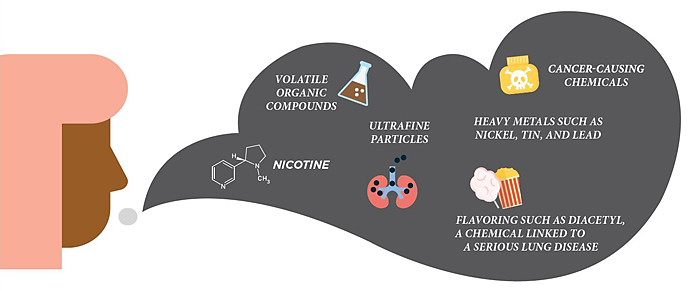The Adolescent Vaping Epidemic
- Filed under "safety"
- Published Wednesday, February 28, 2024
- « back to articles

In the mid-1960, 42% of Americans were smokers. Over the following decades, the rate reduced, but today, smoking remains a habit that Americans have a tough time quitting – the CDC (Centers for Disease Control and Prevention) report that more than 1 in 10 (11.5%) of adults still smoke, whether using e-cigarettes (known as “vapes,” or vape pens), cigars, and pipes.
The use of e-cigarettes has increased, however, among teens and young adults – leading to what is deemed an epidemic among adolescents. When they were introduced in 2007, e-cigarette sales to young people skyrocketed, made even more appealing by adding flavorings that use even more toxic chemicals. Nearly all e-cigarettes contain nicotine; experts note that a typical JUUL cartridge (designed to be sold to adults only, and roughly the size of a USB drive) contains as much nicotine as an entire pack of 20 cigarettes. Two of every 3 JUUL users ages 15-24 report not knowing that JUUL always contains nicotine.
The most common reason for middle and high school students to try e-cigarettes, they report, is that “a friend uses them.” And the most common reason to continue using e-cigarettes is reported to be due to “feeling anxious, stressed, or depressed.” Both e-cigarette and cigarette use in youth has been associated with mental health issues such a depression, according to the CDC.
Current research documents the popularity of vaping among young people:
- 1 in 5 non-smoking high school students used vape pens in 2020
- Over 2.5 million youth used e-cigarettes in 2022
- 85% of adolescents use flavored e-cigarettes
- Youth ages 15 to 17 are 16 times more likely to vape than persons ages 25 to 34
- Over 3 million middle and high school students reported using tobacco products in the past 30 days (U.S. Food and Drug Administration, 2022)

Although the e-cigarette phenomenon is relatively new, the National Academy of Sciences (2019) studied mice exposed to e-cigarette vapors for 54 days, finding that nearly 1 in 4 (22.5%) developed lung cancers and 57.5% developed bladder anomalies leading to cancer.
For children, the effect of e-cigarettes can be devastating - exposure to liquid nicotine (used in e-cigarettes), whether swallowed or absorbed through the skin, can cause seizures, breathing difficulty, and increased heart rate. Poison centers report receiving one call every 3 hours about a child exposed to either e-cigarettes or liquid nicotine.
99% of e-cigarettes contain nicotine, the addictive drug used in typical cigarettes, cigars, and other tobacco products. When exposed to nicotine during adolescence, young people experience damage to the brain affecting learning, attention, and memory. It can also increase risk for addiction to other drugs, and bystanders exposed to the aerosols inhaled and exhaled by users can be exposed to volatile organic compounds, heavy metals, and ultrafine particles containing chemicals that can damage the lungs and airways.
This is a public health epidemic, calling our attention to help protect young people from the risks and dangers of e-cigarettes. Not only do adults need to learn about the types and shapes of e-cigarettes, they need to talk to children and teens about their risks and dangers of their use.
Recently, a group of Chrysalis GirlPower High School Peer Mentors discuss the problem of vaping in their schools – one noted that she didn’t use the school restrooms because there was so much vaping that she found the air unbreathable. Fortunately, they were holding a training meeting in the Chrysalis office, and Brooke Findley, Chrysalis Senior Director of Strategy and Impact, led them to further discuss the issue of vaping, along with its risks. The mentors further explored how to educate themselves and integrate information on the dangers and risks of vaping in their teachings about healthy relationships and healthy decisions.
We are proud of the work of the GirlPower mentors and the efforts of Chrysalis After-School facilitators in reaching girls when they are most vulnerable, preventing girls from making poor decisions that may affect them throughout their lifetimes. We’ve been delivering Chrysalis After-School programs since 1998, and I believe it is the best investment we can make to ensure girls become confident and successful women in the future.